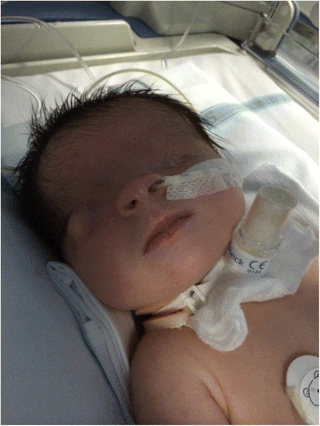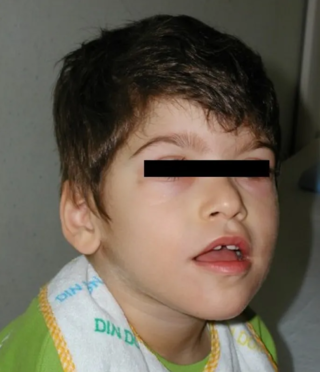Related Research Articles

Asperger syndrome (AS), also known as Asperger's syndrome or Asperger's, is a term formerly used to describe a neurodevelopmental disorder characterized by significant difficulties in social interaction and nonverbal communication, along with restricted, repetitive patterns of behavior and interests. Asperger syndrome has been merged with other disorders into autism spectrum disorder (ASD) and is no longer considered a stand-alone diagnosis. It was considered milder than other diagnoses which were merged into ASD due to relatively unimpaired spoken language and intelligence.

Joubert syndrome is a rare autosomal recessive genetic disorder that affects the cerebellum, an area of the brain that controls balance and coordination.

Williams syndrome (WS), also Williams–Beuren syndrome (WBS), is a genetic disorder that affects many parts of the body. Facial features frequently include a broad forehead, underdeveloped chin, short nose, and full cheeks. Mild to moderate intellectual disability is observed in people with WS, with particular challenges with visual spatial tasks such as drawing. Verbal skills are relatively unaffected. Many people with WS have an outgoing personality, an openness to engaging with other people, and a happy disposition. Medical issues with teeth, heart problems, and periods of high blood calcium are common.
The diagnostic category pervasive developmental disorders (PDD), as opposed to specific developmental disorders (SDD), was a group of disorders characterized by delays in the development of multiple basic functions including socialization and communication. It was defined by the Diagnostic and Statistical Manual of Mental Disorders (DSM), and the International Classification of Diseases (ICD).

Proteus syndrome is a rare disorder with a genetic background that can cause tissue overgrowth involving all three embryonic lineages. Patients with Proteus syndrome tend to have an increased risk of embryonic tumor development. The clinical and radiographic symptoms of Proteus syndrome are highly variable, as are its orthopedic manifestations.

Alagille syndrome (ALGS) is a genetic disorder that affects primarily the liver and the heart. Problems associated with the disorder generally become evident in infancy or early childhood. The disorder is inherited in an autosomal dominant pattern, and the estimated prevalence of Alagille syndrome is 1 in every 30,000 to 1 in every 40,000 live births. It is named after the French pediatrician Daniel Alagille, who first described the condition in 1969. Children with Alagille syndrome live to the age of 18 in about 90% of the cases.

Rubinstein–Taybi syndrome (RTS) is a rare genetic condition characterized by short stature, moderate to severe learning difficulties, distinctive facial features, and broad thumbs and first toes. Other features of the disorder vary among affected individuals. These characteristics are caused by a mutation or deletion in the CREBBP gene, located on chromosome 16, and/or the EP300 gene, located on chromosome 22.

Fraser syndrome is an autosomal recessive congenital disorder, identified by several developmental anomalies. Fraser syndrome is named for the geneticist George R. Fraser, who first described the syndrome in 1962.
Neurodevelopmental disorders are a group of conditions that begin to emerge during childhood. According to the American Psychiatric Association Diagnostic and Statistical Manual of Mental Disorders, Fifth Edition, (DSM-5) published in 2013, these conditions generally appear in early childhood, usually before children start school, and can persist into adulthood. The key characteristic of all these disorders is that they negatively impact a person's functioning in one or more domains of life depending on the disorder and deficits it has caused. All of these disorders and their levels of impairment exist on a spectrum, and affected individuals can experience varying degrees of symptoms and deficits, despite having the same diagnosis.

Medical genetics is the branch of medicine that involves the diagnosis and management of hereditary disorders. Medical genetics differs from human genetics in that human genetics is a field of scientific research that may or may not apply to medicine, while medical genetics refers to the application of genetics to medical care. For example, research on the causes and inheritance of genetic disorders would be considered within both human genetics and medical genetics, while the diagnosis, management, and counselling people with genetic disorders would be considered part of medical genetics.

Carbohydrate-responsive element-binding protein (ChREBP) also known as MLX-interacting protein-like (MLXIPL) is a protein that in humans is encoded by the MLXIPL gene. The protein name derives from the protein's interaction with carbohydrate response element sequences of DNA.

Abhydrolase domain-containing protein 11 also known as Williams-Beuren syndrome chromosomal region 21 protein (WBSCR21) is an enzyme that in humans is encoded by the ABHD11 gene.
Tripartite motif-containing 50, also known as TRIM50, is a human gene. TRIM50 encodes an E3 ubiquitin ligase. The protein encoded by this gene is a member of the tripartite motif (TRIM) family, also called the 'RING-B-box-coiled-coil' (RBCC) subgroup of RING finger proteins. The gene is located at 7q11.23, near two homologous genes, TRIM73 and TRIM74. TRIM50 is deleted in Williams syndrome, a multisystem developmental disorder caused by the deletion of contiguous genes at 7q11.23.

Classic autism, also known as childhood autism, autistic disorder, (early) infantile autism, infantile psychosis, Kanner's autism, Kanner's syndrome, or (formerly) just autism, is a neurodevelopmental condition first described by Leo Kanner in 1943. It is characterized by atypical and impaired development in social interaction and communication as well as restricted, repetitive behaviors, activities, and interests. These symptoms first appear in early childhood and persist throughout life.

Autoimmune polyendocrine syndrome type 1 (APS-1), is a subtype of autoimmune polyendocrine syndrome. It causes the dysfunction of multiple endocrine glands due to autoimmunity. It is a genetic disorder, inherited in autosomal recessive fashion due to a defect in the AIRE gene , which is located on chromosome 21 and normally confers immune tolerance.

Pitt–Hopkins syndrome (PTHS) is a rare genetic disorder characterized by developmental delay, epilepsy, distinctive facial features, and possible intermittent hyperventilation followed by apnea. Pitt–Hopkins syndrome can be marked by intellectual disabilities as well as problems with socializing. It is part of the clinical spectrum of Rett-like syndromes.

Asphyxiating thoracic dysplasia (ATD), also known as Jeune syndrome, is a rare inherited bone growth disorder that primarily affects the thoracic region. It was first described in 1955 by the French pediatrician Mathis Jeune. Common signs and symptoms can include a narrow chest, short ribs, shortened bones in the arms and legs, short stature, and extra fingers and toes (polydactyly). The restricted growth and expansion of the lungs caused by this disorder results in life-threatening breathing difficulties; occurring in 1 in every 100,000-130,000 live births in the United States.

Floating–Harbor syndrome, also known as Pelletier–Leisti syndrome, is a rare disease with fewer than 50 cases described in the literature. It is usually diagnosed in early childhood and is characterized by the triad of proportionate short stature with delayed bone age, characteristic facial appearance, and delayed speech development. Although its cause is unknown, it is thought to result from genetic mutation, and diagnosis is established by the presence of a heterozygous SRCAP mutation in those with clinical findings of FHS.

A microdeletion syndrome is a syndrome caused by a chromosomal deletion smaller than 5 million base pairs spanning several genes that is too small to be detected by conventional cytogenetic methods or high resolution karyotyping. Detection is done by fluorescence in situ hybridization (FISH). Larger chromosomal deletion syndromes are detectable using karyotyping techniques.
References
- ↑ Egger, HL; Emde, RN (2011). "Developmentally sensitive diagnostic criteria for mental health disorders in early childhood: The diagnostic and statistical manual of mental disorders—IV, the research diagnostic criteria—preschool age, and the Diagnostic Classification of Mental Health and Developmental Disorders of Infancy and Early Childhood—Revised". American Psychologist . 66 (2): 95–106. doi:10.1037/a0021026. PMC 3064438 . PMID 21142337.
- ↑ Oztop, D; Uslu, R (2007). "Behavioral, interactional and developmental symptomatology in toddlers of depressed mothers: A preliminary clinical study within the DC:0-3 framework". The Turkish Journal of Pediatrics . 49 (2): 171–8. PMID 17907517.
- ↑ Kamath, BM; Stolle, C; Bason, L; Colliton, RP; et al. (2002). "Craniosynostosis in Alagille syndrome". American Journal of Medical Genetics. 112 (2): 176–80. doi: 10.1002/ajmg.10608 . PMID 12244552.
- ↑ Turnpenny, PD; Ellard, S (2011). "Alagille syndrome: Pathogenesis, diagnosis and management". European Journal of Human Genetics. 20 (3): 251–7. doi:10.1038/ejhg.2011.181. PMC 3283172 . PMID 21934706.
- ↑ Hendrix, JD Jr; Greer, KE (1996). "Rubinstein-Taybi syndrome with multiple flamboyant keloids". Cutis; Cutaneous Medicine for the Practitioner. 57 (5): 346–8. PMID 8726717.
- ↑ "Rubinstein-Taybi syndrome: MedlinePlus Genetics".
- ↑ Melekos, M; Barbalias, G; Asbach, HW (1987). "Rubinstein-Taybi syndrome". Urology. 30 (3): 238–9. doi:10.1016/0090-4295(87)90242-1. PMID 3629765.
- ↑ Rio, T; Urbán, Z; Csiszár, K; Boyd, CD (2008). "A gene-dosage PCR method for the detection of elastin gene deletions in patients with Williams syndrome". Clinical Genetics. 54 (2): 129–35. doi:10.1111/j.1399-0004.1998.tb03715.x. PMID 9761391. S2CID 12793159.
- ↑ Scheiber, D; Fekete, G; Urban, Z; Tarjan, I; et al. (2006). "Echocardiographic findings in patients with Williams-Beuren syndrome". Wiener Klinische Wochenschrift. 118 (17–18): 538–42. doi:10.1007/s00508-006-0658-2. PMID 17009066. S2CID 41861608.
- ↑ Bellugi, U; Wang, PP; Jernigan, TL (1994). "Williams Syndrome: An Unusual Neuropsychological Profile". In Broman, SH; Grafman, J (eds.). Atypical Cognitive Deficits in Developmental Disorders: Implications for Brain Function. Taylor & Francis. pp. 23–56. ISBN 978-0-8058-1180-3.
- ↑ Morris, CA; Lenhoff, HM; Wang, PP (2006-02-13). Williams-Beuren Syndrome: Research, Evaluation, and Treatment. JHU Press. p. 237. ISBN 978-0-8018-8212-8.
- ↑ Kaduthodil, M; Prasad, D; Lowe, A; Punekar, A; et al. (2012). "Imaging manifestations in Proteus syndrome: An unusual multisystemdevelopmental disorder". British Journal of Radiology. 85 (1017): e793–9. doi:10.1259/bjr/92343528. PMC 3487101 . PMID 22514103.
- ↑ Tosi, LL; Sapp, JC; Allen, ES; O'Keefe, RJ; et al. (2011). "Assessment and management of the orthopedic and other complications of Proteus syndrome". Journal of Children's Orthopaedics . 5 (5): 319–27. doi:10.1007/s11832-011-0350-6. PMC 3179535 . PMID 23024722.
- ↑ Morgan, NV; Bacchelli, C; Gissen, P; Morton, J; et al. (2003). "A locus for asphyxiating thoracic dystrophy, ATD, maps to chromosome 15q13". Journal of Medical Genetics. 40 (6): 431–5. doi:10.1136/jmg.40.6.431. PMC 1735497 . PMID 12807964.
- ↑ Tongsong, Theera; Chanprapaph, Pharuhus; Thongpadungroj, Tidarat (1999-08-01). "Prenatal sonographic findings associated with asphyxiating thoracic dystrophy (Jeune syndrome)". Journal of Ultrasound in Medicine. 18 (8): 573–6. doi:10.7863/jum.1999.18.8.573. PMID 10447085. S2CID 33532185.
- 1 2 3 4 5 6 7 Woliver, Robbie (2009). Alphabet Kids. Jessica Kingsley Publishers. p. 295.